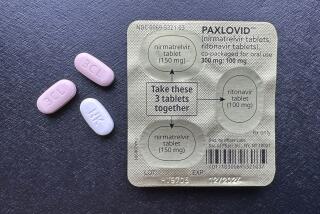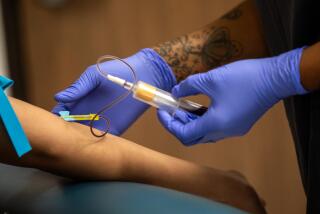HIV Testing Urged in All Pregnancies
- Share via
Federal health officials will unveil a new HIV testing strategy today designed to expand screening among pregnant women and about 200,000 others who are infected with the virus but do not know it.
The new strategy by the U.S. Centers for Disease Control and Prevention specifically urges the testing of all pregnant women, rather than relying upon them to volunteer.
The change is intended to ensure that newborns receive highly effective drugs if their mothers are infected, which could dramatically reduce mother-to-child transmission from its current level of about 300 cases per year.
More broadly, the guidelines are intended to make HIV testing a routine part of care in doctors’ offices and clinics, rather than waiting for patients to specifically request it.
CDC Director Dr. Julie L. Gerberding said in an interview with The Times that the guidelines stem from the realization that existing HIV prevention programs “have really stalled recently.”
“Where we are right now is pretty intolerable,” she said.
With the number of new HIV cases hovering around 40,000 annually for the past decade, Gerberding and many other public health officials say it is time for physicians to screen for HIV in the same way they do for other conditions, such as diabetes or hypertension.
The strategy, outlined today in the CDC’s Morbidity and Mortality Weekly Report, is only advisory but has some authority: The agency will ask state and local governments to adhere to it in exchange for federal funding. Most states depend on such money for prevention efforts.
Dr. Anthony Fauci, director of the National Institute of Allergy and Infectious Diseases, said the guidelines represent a “much more aggressive approach toward HIV prevention” nationally, which he said is “a long time in coming.”
“We know from experience that the vast majority of people, when they know they’re infected, they become much more careful with their sexual partners,” Fauci said. “Testing is really the gateway to a realization of a problem.”
The CDC recommendation that is likely to spur the most debate is blanket testing of pregnant women. If mothers refuse, the CDC is asking states to test newborns for the virus so they can receive treatment if they are infected.
“Right now, what’s happening in a lot of places is doctors say, ‘You’re a nice girl, you’re not at risk,’ ” said Dr. Andrea Kovacs, director of the Comprehensive Maternal-Child and Adolescent HIV Management and Research Center at Los Angeles County-USC Medical Center. “Nobody knows who’s at risk. Since this is now a preventable infection for a deadly disease, we really need to do the maximum we can to prevent transmission.”
Pregnant women are now routinely tested for several diseases, such as syphilis, rubella, Group B Strep and hepatitis, without being specifically asked for consent.
Doctors say they can dramatically reduce the risk of HIV transmission from mother to child if a woman takes anti-AIDS drugs during pregnancy and avoids breastfeeding after birth. Even if a woman receives no prenatal care, hospitals can take steps to prevent HIV transmission to newborns. If the virus is identified in a woman during childbirth or immediately afterward, her baby can be given drugs during the first 24 hours of life, substantially reducing the risk of infection.
California Gov. Gray Davis vetoed a bill last year that would have created a mandatory testing system unless a pregnant woman opted out. He said the voluntary system appeared to be working, adding that he would not want to discourage women from obtaining prenatal care.
“We are looking very carefully at whether the approach that California has taken, by requiring physicians to advise women” about testing, is effective, said Michael Montgomery, director of the state office of AIDS.
Still, he added, “I would encourage anybody that might have any risk factor to be tested for HIV.”
CDC data show that voluntary systems don’t work as well as opt-out systems.
In an effort to reach more of the 200,000 people who may be unwittingly spreading HIV, the CDC is encouraging local public health authorities to make widespread use of a new rapid test, approved by federal regulators in November, which can provide results in less than 20 minutes.
The CDC wants to offer the test in all federally funded clinics, as well as such venues as shelters for the homeless, jails and substance abuse treatment centers, where people may not have access to routine medical care.
Gerberding said she also wants doctors to be much more proactive in HIV screening and testing. Many physicians have shied away from encouraging patients to be tested for HIV because of what they have viewed as onerous requirements to provide extensive counseling before blood is drawn. The agency wants to streamline that process.
Another part of the CDC’s new strategy is to place a greater emphasis on helping people who are already infected with HIV to understand that it is their responsibility not to infect others. Gerberding said this marks a shift because prevention efforts have until now focused largely on changing the behavior of the uninfected.
States are expected to integrate the CDC’s guidelines into their HIV programs, but the agency will also allocate $35 million in new federal funds to allow states to try alternative approaches that get patients diagnosed and into treatment, she said.
For many years, doctors and public health officials have treated HIV as a disease like no other, mainly because of fears that infected patients would fall victim to discrimination or be stigmatized. As a result, some critics say, the focus has been more on preserving patient’s privacy and discretion than on aggressive public health measures used for all other sexually transmitted and infectious diseases.
It’s time to change that, said Dr. Tom Coburn, a former congressman from Oklahoma and co-chairman of the President’s Advisory Council on HIV/AIDS. “The country is a lot different now than it was in 1983,” he said. “Although there are rednecks still in every corner, the vast majority of people understand this disease [and] want to help those that have it.”
Michael Weinstein, president of the AIDS Healthcare Foundation, said public health has suffered because doctors have been forced to tiptoe around the disease.
“We’re reinforcing the stigma of AIDS by saying it has to be treated differently and by saying it has to be hidden,” he said.
Some AIDS prevention groups say the push for more testing needs to be tempered by the reality that positive results carry serious implications.
“For a lot of low-income clients in minority populations, the stigma is still very real,” said Dana Van Gorder, director of state and local affairs for the San Francisco AIDS Foundation. “We’re not inventing that. People can be subject to discrimination. Women can be subject to harassment by boyfriends or husbands as a result of these tests. We just think they need to go into it with full knowledge of what’s going on.”
Charles Henry, director of Los Angeles County’s Office of AIDS Programs and Policy, said testing patients for HIV is not enough.
“You have to make sure that you have primary care available” afterward, Henry said. “We have a huge uninsured and underinsured population. We have a lot of challenges” ahead.






